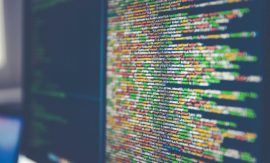Intended learning outcomes: Disclose issues and challenges of ERP software and SCM software throughout the last decades.
ERP software was originally designed for modeling products and production processes, administering orders, and preparing accounts. These tasks were soon supplemented with planning functions for resource management (goods and capacity).
Between 1960 and 1980, many companies developed their own company-specific software that was precisely tailored to their needs. Data were then transferred from forms to punched cards and processed in batches at computer centers. The range of such software was generally just a few years. A new software generation came in the late 1970s, with the development of the computer monitor (character format with 24 rows * 80 characters). Relational databases that could handle large volumes of data first appeared at roughly the same time. These provided users with direct access to the data and to the programs that process this data (online or interactive techniques). The software from this period is sometimes still in use today, enhanced by the graphical user interface (GUI) introduced in the late 1980s.
ERP standard software was only seen in large companies up until the mid-1970s. The most common applications could be found in companies with logistics characterized by convergent product structures, batch production, and production with order repetitionand with high utilization of capacity as their entrepreneurial objective. The first generation of standard software, such as the Copics package, was also developed for this user profile. Since then, standard software gradually improved to also meet at least partially the needs of small- and medium-sized companies and their flexible forms of organization. Since the mid-1990s, software for SCM has also been available.
Current software challenges in the areas of ERP and SCM are due, for one thing, to technological developments. Mobile end user devices such as iPhone and iPad increase the demand for mobile applications, making it possible to use various ERP or SCM software functionalities independent of location. “Cloud computing” means that the data and programs are no longer stored on an individual computer. Large main storages allow “in-memory computing,” which means that the data no longer have to be read by a hard disk storage unit and instead are kept in the main storage.
In the organizational area, software is currently challenged by the globalization of firms. The software has to be able to be linked up globally, which is not easy owing to different languages, some of them not alphabetic, and local differences in the qualifications of personnel. In addition, there continues to be a demand for increased customization of functionality. Service-oriented architecture (SOA) has been developed to meet this demand. SOA is the concept of encapsulating functionalities in loosely coupled services, which can then be flexibly combined for new application functionalities.
ERP and SCM software is still surprisingly long-lasting. The typical life span is 10 years or more, and 20 years is not unusual.[note 903] What is the reason for this longevity? A change of hardware or software is both expensive and full of risks: for integrated packages, in particular, it would affect every operational order processing system — and thus a large number of users and a wide range of IT-supported processes. Any mistakes would immediately have a detrimental effect on the company’s ability to add value and thus to do business. In addition, the ERP and SCM software developers who enter the market take too little notice of the requirements of the users, with the result that packages created using the latest technology have inadequate data models and functionality.
Course section 9.1: Subsections and their intended learning outcomes

9.1 Software in the Area of ERP and SCM: An Introduction
Intended learning outcomes: Produce an overview on history and origin of ERP software. Disclose scope and range of ERP and SCM software.

9.1.1 History and Origin of ERP Software
Intended learning outcomes: Differentiate between things that have changed and things that have not changed since the introduction of data processing. Describe the use of the Hollerith system at operational level.

9.1.2 Scope and Range of ERP Software and SCM Software
Intended learning outcomes: Disclose issues and challenges of ERP software and SCM software throughout the last decades.
